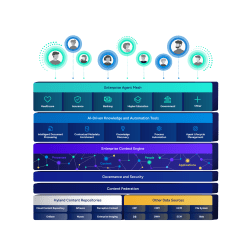How can a DAM taxonomy enhance business processes?
A DAM taxonomy can work wonders to enhance your creative workflows and overall productivity. Conceptualizing, planning and executing marketing campaigns takes significant effort, and implementing a DAM taxonomy facilitates more efficient processes and greater transparency over company assets.
Bringing order to the asset chaos in turn empowers creatives to easily find, manage and repurpose existing content, accelerating production times while ensuring consistent brand messaging across all deliverables.
Automated DAM taxonomy and AI
For organizations looking to create automated workflows, cloud-native DAM solutions such as Hyland’s Nuxeo Platform for DAM enable users to build custom, automated process flows via a low-code workflow engine. These workflows standardize and automate the asset management process, with features like task notifications and unprocessed asset escalations keeping content moving smoothly down the creative pipeline.
Additionally, an AI-powered DAM solution like Nuxeo Platform’s can incorporate machine learning and artificial intelligence into the tagging and classification process. This not only speeds processes, but also drives accuracy.
> Read more: A beginner’s guide to digital asset management workflows
5 steps to build a DAM taxonomy for your organization
The process for building and implementing a DAM taxonomy involves five main steps:
1. Conduct a digital asset management audit
The first step in building a DAM taxonomy is to identify who needs to access what assets and what type of assets they want to store. Identifying who will use and store assets on the DAM system will help you create a more relevant taxonomy structure with classifications that your target users can understand.
Consulting users is essential if multiple teams are going to be accessing creative assets. For example, if your marketing team and your sales team need to access the same assets, communicate with both to find categories that are relevant to each team’s requirements.
2. Audit existing digital assets and folder structures
The next step is to take an inventory of all existing assets in relevant folders, personal drives, cloud storage solutions or network drives and consolidate them into a single location. This is also a good time to perform an asset declutter, such as deleting duplicate files or archiving outdated assets.
For the best results, import all assets that your employees will need to use on a day-to-day basis.
3. Identify new categories for your digital assets
After identifying your assets, it’s time to think about the categories and sub-categories you could use to organize them. For example, you can use videos and photos as parent categories and then have subcategories like social media or print marketing to further filter through assets.
When creating new categories for assets, you can start by mapping out a potential list of categories that your team members may use to locate the content they need, utilizing it as a starting point for further discussion or refinement. The most important thing is to tailor these categories to the needs of your users.
4. Document your DAM taxonomy and file naming conventions
Once you’ve decided what categories to break your assets down into, you can start to document them. Using a simple spreadsheet to keep track of your categories is normally the best way to do so.
It’s important to note that it may take a few rounds of revisions before your taxonomy is ready for deployment. After finalizing your preliminary taxonomy, you can then import it to your DAM platform for your users to try out.
5. Test and update your DAM taxonomy
After finalizing the taxonomy, routinely test (quarterly or annually) and revise its categories to ensure that the tags applied are still helping users discover assets quickly. One way to test your taxonomy is to give users a list of files to discover and observe how long it takes them to find the content. You can also review past search logs to view successful and failed searches.
At this stage of the process, testing and updating your taxonomy is about whether you have the optimal tags for employees to use and maximizing the speed at which they can find assets. The fewer clicks it takes to discover creative content, the more effective your taxonomy is.
> Read more: Why you should choose an open source digital asset management software
A clear DAM taxonomy pays dividends
Taking the time to set out clear and concise DAM file naming conventions will enable your users to find the assets they need without wasting hours sifting through filters to find creative content. While it involves a lot of planning, being prepared will pay dividends over the long term as your digital asset management process becomes more efficient.
Ultimately, the more streamlined your asset management process is, the easier it will be for your employees to find creative assets and produce high-performance and high-level marketing campaigns.
Browse more articles:

















